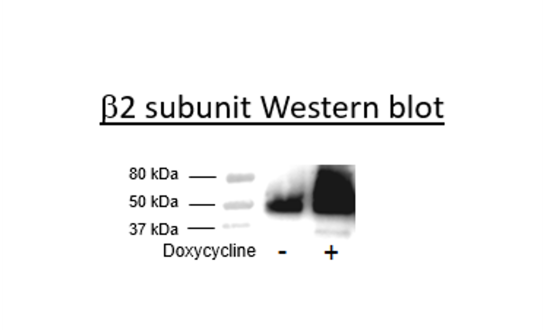Nav1.8/β2 - HEK293 Recombinant Cell Line
Catalog #
60521
$9,400
*
●
●
Purchase
Description
Stable recombinant HEK293 cell line expressing tetracycline-inducible human Nav1.8 (Genbank #NP_006505.2) fused to Green Fluorescent Protein (GFP) [Ex. ~395 nm, 475 nm; em ~510 nm] and the human sodium channel β2 subunit (Genbank #NM_004588; SCN2B). Nav1.8 is also known as tetrodotoxin-resistant voltage-gated sodium channel type X (SCN10A).
Purchase of this cell line is for research purposes only; commercial use requires a separate license. View the full terms and conditions.
●
Synonyms
NAV
●
Product Data Gallery
Product Info
Storage and Usage
Citations
Host Cell Line
HEK293 Cells
Species
Human
Format
Each vial contains ~1 X 106 cells in 10% DMSO solution
Amino Acid Sequence
A synthetic codon-optimized DNA sequence encoding human Nav1.8 (SCN10A gene) with C-terminal GFP-tag and C-terminal Streptavidin-Binding Peptide (SBP)-tag, and the SCN2B gene encoding human β2 subunit with C-terminal FLAG-tag are stably integrated in tetracycline-inducible HEK293 cells.
Genbank #
NP_006505.2, NM_004588
UniProt #
Q9Y5Y9, O60939
Mycoplasma Testing
The cell line is confirmed for absence of Mycoplasma species using the PCR-based VenorGeM® Mycoplasma Detection kit (Sigma Aldrich).
Background
Nav1.8 is a voltage gated type X, alpha subunit sodium channel which in humans is encoded by the SCN10A gene. It is expressed in nociceptors and has been proposed as a target for the development of new analgesics. Mice deficient in Nav1.8 have deficits in sensing inflammatory pain (initiated by tissue damage/inflammation) and visceral pain (initiated by damage or injury to internal organs) but not neuropathic pain. Native sodium channels are complexes composed of the pore-forming α subunit and an auxiliary β subunit. The sodium channel β2 subunit, encoded by the SCN2B gene, increases current amplitude and surface expression of sodium ion channels.
References
1. Catterall, W.A. et al. Pharmacol. Rev. 57 (4): 397–409 (2005).
2. Muzny, D.M., et al. Nature 440:1194-1198 (2006).
3. Wilson, D.S., et al. Protein Expression and Purification 23 (3): 440–446 (2001).



